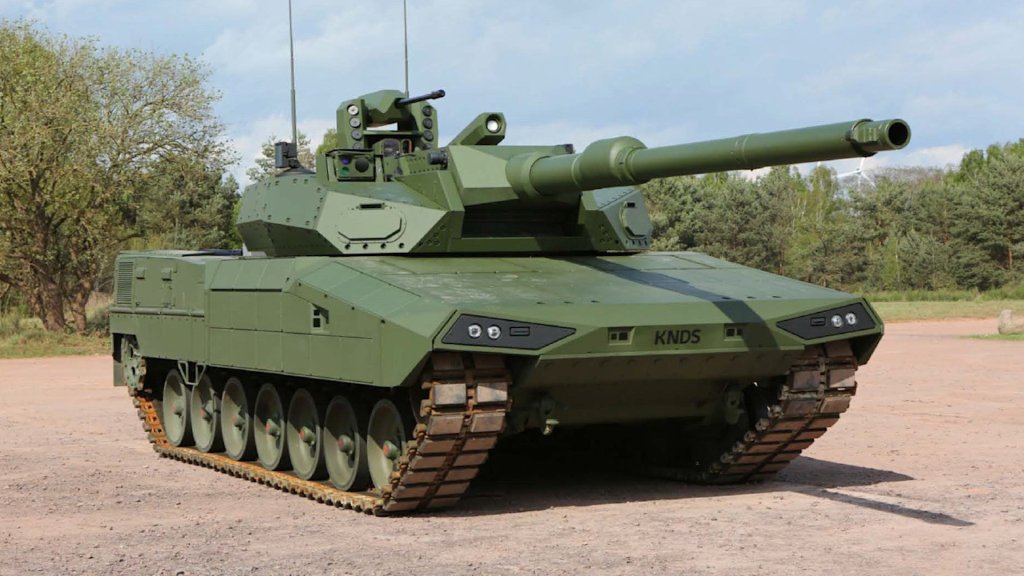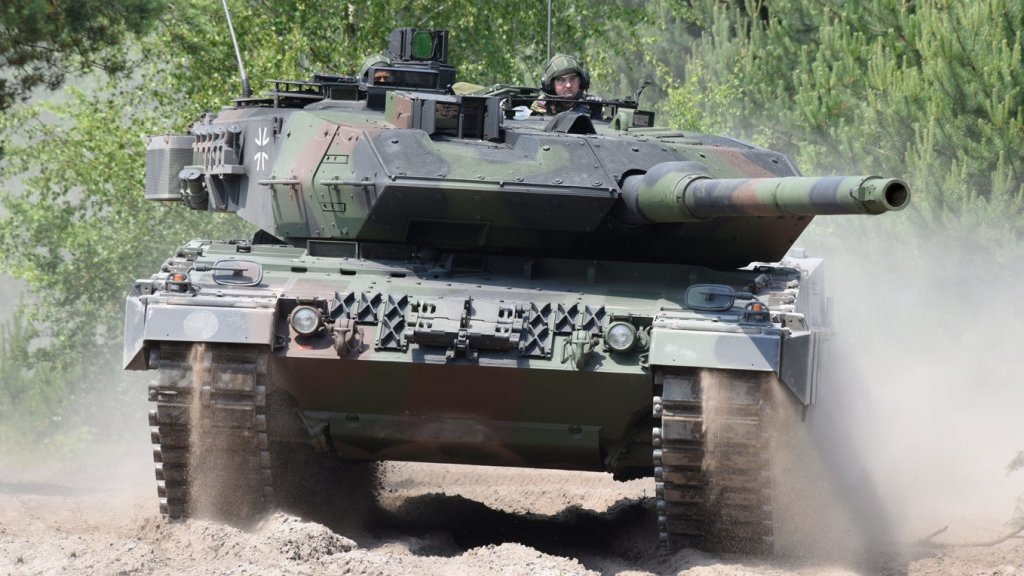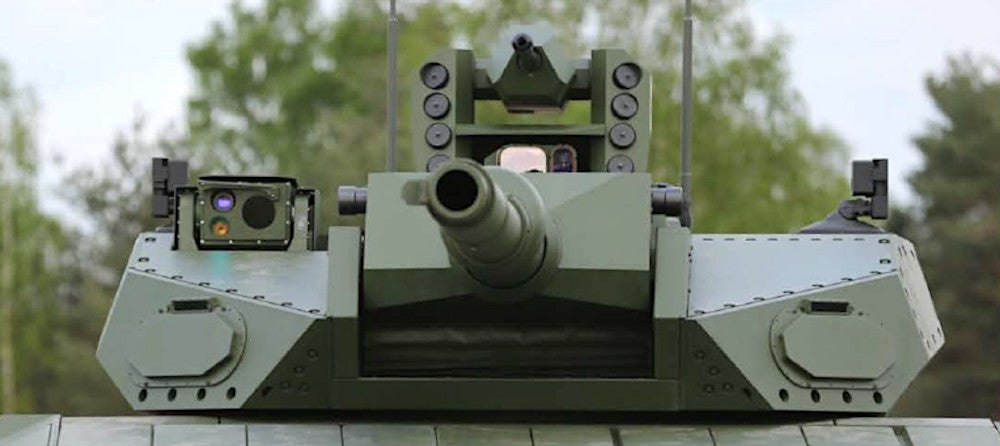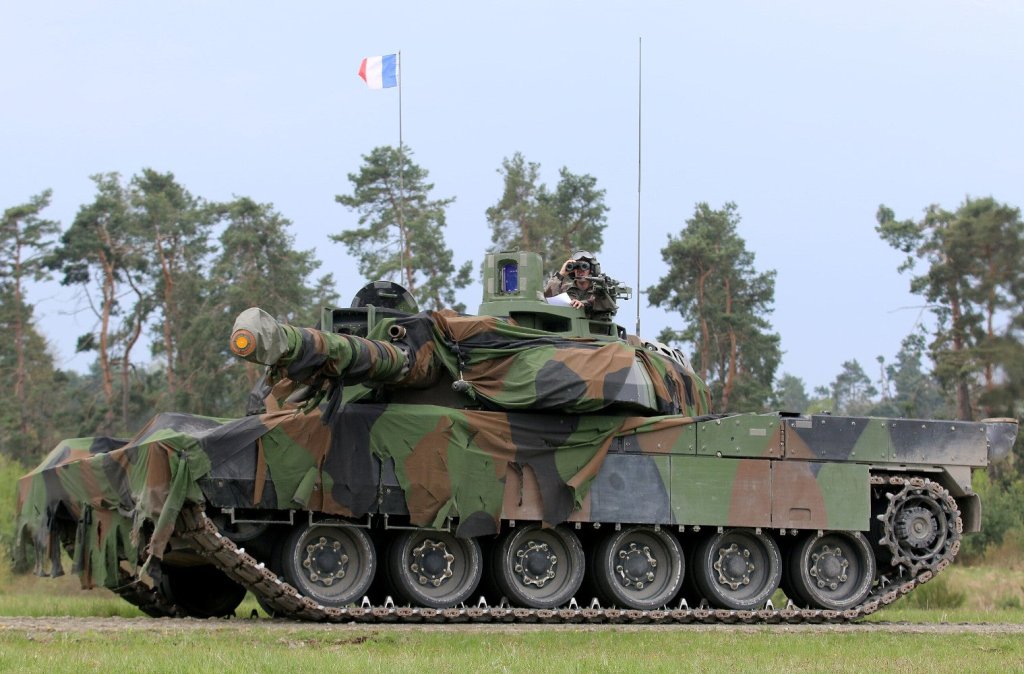Franco-German defense conglomerate KNDS has rolled out a new version of its popular Leopard 2 tank with a completely uncrewed turret that can be armed with a big 140mm main gun. KNDS plans to offer the tank for sale, but also expects it to be a key stepping stone to a next-generation tank for France and Germany.
KNDS provided new details about what it has dubbed the Leopard 2 A-RC 3.0 in a press release today ahead of the Eurosatory defense exposition, which opens next week in Paris, France. The tank, which also features a remote weapon station armed with a 30mm cannon expressly said to be capable of engaging drones, a threat that has now fully emerged thanks to the war in Ukraine, first broke cover yesterday. The design, which also has a built-in anti-tank guided missile launcher and is lighter than current-generation variants of the Leopard 2, is broadly reminiscent in some ways of the AbramsX that U.S. firm General Dynamics Land Systems unveiled last year.

As already noted, the most significant new feature on the Leopard 2 A-RC 3.0 is its new turret, which is a modular design. KNDS says that this means the tank could be armed with existing 120mm main guns (currently the default for Western tanks), as well as future 130mm and 140mm types it has been working on for years now, depending on the customer’s preference.
Earlier this week, KNDS separately announced the successful completion of another round of testing of its Ascalon gun system, which is also capable of being readily converted from 120mm to 140mm (as well as 130mm) and back again, as required. The company says the swap can be made in just one hour.

The plan now is to test Ascalon installed on an actual tank. KNDS’ press release today says it will be displaying its previously unveiled Enhanced Main Battle Tank (EMBT) demonstrator fitted with an uncrewed ADT 140 turret armed with a 140mm version of Ascalon at Eurosatory alongside the Leopard 2 A-RC 3.0.

Since its turret has nobody inside, Leopard 2 A-RC 3.0 will use an autoloader to feed ammunition into whatever type of main gun is installed. KNDS says the vehicle will be able to fire three rounds in 10 seconds. The ammunition storage system is modular to further accommodate the different caliber options.
Compared to existing Leopard 2s and their four-person crew, which includes a dedicated loader, the new turret means the A-RC 3.0 version will need only three people to operate the tank. Those individuals will also all be situated together in a compartment in the hull, which KNDS says will reduce their overall vulnerability by 30 percent.

The uncrewed turret is also flatter than the crewed ones used on the existing Leopard 2 variants, giving the A-RC 3.0 a lower profile. That looks to be unchanged by the addition of the pop-up anti-tank guided missile launcher, which appears to stow flush in the turret when not in use. KNDS says that the launcher can accommodate various line-of-sight and non-line-of-sight missile types. Though not expressly noted, it is possible that the turret-mounted launch system on the Leopard 2 A-RC 3.0 could also be used to deploy drones or loitering munitions.

The Leopard 2 A-RC 3.0’s new 30mm cannon-armed remote weapon station, which also has built-in smoke grenade launchers, does prominently stick up above the turret’s roof. KNDS explicitly touts the counter-drone capabilities of this secondary weapon system.
The ongoing conflict in Ukraine has fully exposed how even well-protected modern Western tanks are vulnerable to weaponized drones, especially small and highly maneuverable first-person view kamikaze types. The need for added defenses against uncrewed aerial threats is clear and is only set to become an absolutley critical aspect of future armored vehicle design.
The next-generation Leopard 2 concept also has an active protection system installed on the turret. This looks to be a version of the Israeli-designed Trophy, which KNDS has been integrating onto newer variants of the Leopard 2. The combat-proven Trophy system consists of an array of small radars along with launchers that are pre-loaded with multiple ‘hard-kill’ projectiles. The radars detect incoming threats and cue the launchers to engage them.

The projectiles that Trophy’s launchers fire are primarily intended to destroy or at least disrupt anti-tank guided missiles and other kinds of infantry anti-armor weapons, such as shoulder-fired rockets and rocket-propelled grenades, by physically smashing into them. The War Zone has previously explored in detail how hard-kill active protection systems like Trophy could give tanks and other armored vehicles another valuable layer of protection against drones. There is also a growing field of relatively small radar-assisted counter-drone systems, including ones that with guns as their effectors, raising the question of whether the Leopard 2 A-RC 3.0’s remote weapon station could be linked to the active protection system’s radars.

The pictures KNDS has shown so far of the Leopard 2 A-RC 3.0 design also show it fitted with arrays of explosive reactive armor on the front and portions of the sides of the hull.
KNDS says that the Leopard 2 A-RC 3.0’s design has other advanced features including a sensor suite optimized in part for future crewed-uncrewed teaming and highly automated fully digital fire control and other systems, including drive-by-wire functionality. This feature could lend itself to an uncrewed capability sometime in the future.

On top of everything else, the Leopard 2 A-RC 3.0 is expected to be notably lighter than existing variants of the Leopard 2. KNDS says the tank’s total weight could be as low as 60 tons depending on its exact configuration. The Leopard 2A7+, one of the most advanced production variants available now, tips the scales at around 72 tons. A major reduction in weight would give the new version improved mobility and transportability, and could offer additional benefits in terms of fuel economy.

There is no indication, at least so far, that the Leopard 2 A-RC 3.0 will include a new propulsion system, or the option to install one. The aforementioned AbramsX demonstrator notably has a hybrid propulsion system that provides a significant boost in fuel efficiency and has a silent operating mode that offers immense tactical advantages. AbramsX is expected to serve as the basis for a new variant or derivative of the Abrams for the U.S. Army, which is currently referred to as the M1E3.

Altogether, “KNDS assesses the Leopard 2 A-RC 3.0 not only as a bridge solution until [the] introduction of the next-generation land combat system MGCS, but also as a decisive technological precursor to MGCS,” according to the press release put out today.
The Franco-German Main Ground Combat System (MGCS) program, which kicked off in 2017, includes plans for a new main battle tank, as well as a ‘system of systems’ of other crewed and uncrewed vehicles. The tank component is expected to ultimately replace Germany’s existing Leopard 2s, as well as France’s Leclercs. KNDS says it will also be displaying a new Leclerc Evolution variant with a crewed turret armed with a 120mm Ascalon gun at Eurosatory.

KNDS announced earlier this year that it would be establishing a new joint company with Germany’s Rheinmetall and Thales in France specifically to work on MGCS.
Rheinmetall notably unveiled its own next-generation KF51 Panther tank back in 2022. The KF51 has a 130mm main gun in a more traditional crewed turret that also has a built-in launcher for missiles or drones and the option to install a remote weapon station on top. You can read more about the Panther’s design and capabilities here.

German media reports had previously suggested that Rheinmetall was dissatisfied with its place within the MGCS program. As such, Leopard 2 A-RC 3.0, looks set to immediately find itself in direct competition with the KF51, especially for sales outside of France or Germany. A KF51 variant for Hungary, which is a current Leopard 2 operator, is already in the works and Ukraine could also be in line to acquire the type. Rheinmetall said just this week that it is still planning to establish an armored vehicle production facility in Ukraine to make Lynx infantry fighting vehicles and potentially KF51s in the future.
KNDS has said that existing Leopard 2 variants can be brought up to the new A-RC 3.0 standard, which could be an attractive option for current operators of the type depending on the exact cost and complexity of that conversion.
KNDS, as well as Rheinmetall, both face competition from outside of Europe. General Dynamics Land Systems has made a number of significant new sales of Abrams variants in recent years. South Korea’s Hyundai Rotem has very actively pitching versions of its K2 tank, including in Europe. Poland, which operates Leopard 2s, has notably acquired a fleet of Abrams and is now in the process of receiving K2s as a part of a massive military modernization effort. Leopard 2 variants and Abrams tanks have gone to Ukraine, too, where they have been actively seeing combat.
More details about the Leopard 2 A-RC 3.0, as well as KNDS’ plans for Leclerc and the Ascalon gun, all of which are feeding into the continued push toward a new Franco-German next-generation tank design, are expected to come next week at Eurosatory.
Contact the author: joe@twz.com
